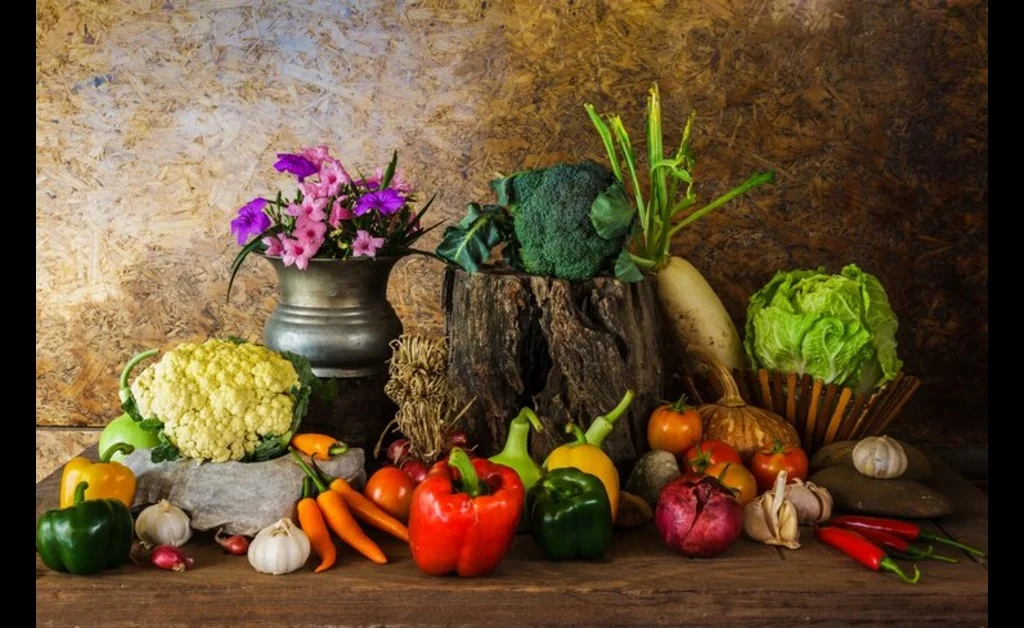Introduction
As the new year rolls around, avid gardeners start dreaming of the lush, productive gardens they’ll cultivate. If you’re looking to fill your plates with fresh, nutrient-packed veggies in 2024, now is the time to plan your garden. In this comprehensive guide, we’ll explore 11 versatile and rewarding vegetable varieties that promise a bountiful harvest throughout the 2024 growing season.
Why Grow Your Own Veggies in 2024?
Growing your own vegetables has numerous benefits that make it a worthwhile endeavor year after year. Here are some key advantages:
- Cost Savings: A well-tended veggie garden can yield an abundance of fresh produce at a fraction of the cost of grocery store prices. According to a study by the National Gardening Association, the average family with a basic vegetable garden can grow $600 worth of produce on just a quarter acre!
- Unbeatable Freshness and Flavor: Vegetables picked straight from your garden simply taste better! The flavors are richer and more vibrant compared to store-bought produce that was picked days or weeks earlier while unripe and built to withstand transportation and storage.
- Sense of Accomplishment: There’s a special pride and satisfaction that comes from enjoying food you’ve grown with your own hands. It’s a rewarding hobby that provides a tangible connection to your meals.
- Environmental Benefits: Home gardening is a sustainable practice that reduces your carbon footprint and reliance on industrialized agriculture. You can minimize resource waste by only growing what you’ll consume.
- Family Bonding: Gardening together can be a fun, educational activity for kids and a great way to spend quality time outdoors as a family. It teaches valuable lessons about food origins, patience, responsibility, and nature appreciation.
- Health Benefits: Fresh, nutrient-dense vegetables are vital for a balanced diet. Having a steady supply increases your household’s veggie consumption. Gardens also provide light exercise and stress relief from tending the plants.
Planning Your 2024 Vegetable Garden
Before diving into which veggies to plant, it’s crucial to lay the groundwork for a successful garden. Here are some planning tips:
- Consider Your Climate: Research your local hardiness zone and which vegetable varieties thrive best in your climate conditions. This will maximize your chances of a bountiful harvest. The offered varieties may need to be adjusted.
- Assess Sunlight Exposure: Most vegetables need at least 6-8 hours of direct sunlight per day. Evaluate the sunniest areas of your yard or garden space. Shady spots can still support leafy greens and root vegetables.
- Rotate Crop Locations: To prevent disease and nutrient depletion, avoid planting the same crops in the same spot year after year. Rotate locations annually using a multi-year planting pattern.
- Start Seeds Indoors: Get a jump on the season by starting seeds for warm-weather crops like tomatoes and peppers indoors 6-8 weeks before your last expected frost date. This allows transplants to go in the ground earlier.
- Amend Soil: Before planting, till in nutrient-rich compost or aged manure to improve your garden’s soil quality, fertility, and drainage. Perform a soil test to check pH and nutrient levels.
- Plan Your Layout: Sketch out a diagram of where you’ll plant each crop, arranging tall plants on the north side to avoid shading shorter veggies. Group plants with similar needs together to make maintenance easier.
- Use Intensive Planting: To maximize your space, utilize intensive planting methods like wide rows, successive plantings of short-season crops, trellising vining plants, and inter-planting fast and slow-growers.
The 11 Top Veggies to Grow in 2024
Now for the stars of the show – the must-grow vegetable varieties for your 2024 garden! I’ve personally had great success with these rewarding crops:
1. Tomatoes
Ah, the quintessential garden veggie! Tomatoes are incredibly prolific producers and so versatile for cooking. Here are some tips for growing luscious tomatoes:
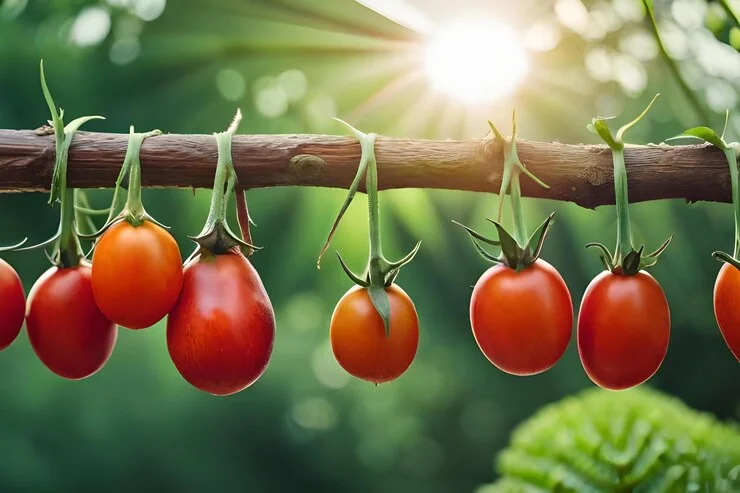
- Ideal Conditions: Tomatoes love hot, sunny conditions with temperatures between 70°F-85°F. They require at least 6-8 hours of direct sun per day and well-draining soil.
- Planting Times: Set out transplants 2-3 weeks after your last spring frost date. In warm climates, you can plant a second crop in late summer for a fall harvest.
- Supporting Growth: Stake, trellis or cage indeterminate (vine) varieties to keep plants upright and improve air circulation. This also prevents fruits from resting on soil. Determinate bush types may still need lighter support.
- Watering Needs: Tomato plants need about 1-2 inches of water per week, either from rain or manual irrigation. Inconsistent watering can cause blossom end rot or cracking.
- Feeding: In addition to nutrient-rich soil, supplement with a balanced vegetable fertilizer or compost tea every 2-3 weeks for a continuous supply of flowers and fruits.
- Varietals to Try: Cherokee Purple (heirloom beefsteak), Sun Gold (cherry), Better Boy (slicing), San Marzano (paste tomatoes), or a compact patio variety if you’re short on space.
“The garden is a metaphor for life, with the tomato representing our personal journey from seed to blossom to fruit.” – Unknown
2. Peppers
From sweet bells to spicy chili varieties, peppers are another warm-weather staple. They make tasty additions to salsas, stir-fries, and so much more.

- Growing Conditions: Like tomatoes, peppers thrive in hot, sunny exposures with light, well-draining soil enriched with compost or fertilizer. Applying mulch helps retain moisture.
- Planting Periods: Set out transplants 2-3 weeks after last spring frost. In long, warm seasons you can succession plant every 3-4 weeks for a continual harvest.
- Spacing and Support: Space pepper plants 12-18″ apart in rows. Use stakes, cages, or small tomato ladders for support as plants mature and become heavy with fruit.
- Pollination Needs: While not entirely self-pollinating, most pepper varieties will still set fruit through wind and insect pollination. Gently shaking plants can also help distribute pollen.
- Handling Heat: To develop their maximum flavor and spice, hot pepper varieties need very warm days (above 80°F) and warm nights (70°F+) especially as fruits mature.
- Varieties to Grow: Jalapeño, habanero, Anaheim, cayenne, or go mild with bells like Red Knight or banana peppers. Colorful varieties like Purple Beauty add zest to dishes.
3. Zucchini/Summer Squash
These prolific beauties will keep you overflowing with squash if you’re not careful! Zucchini and summer squashes like yellow crookneck thrive in warm summer gardens.
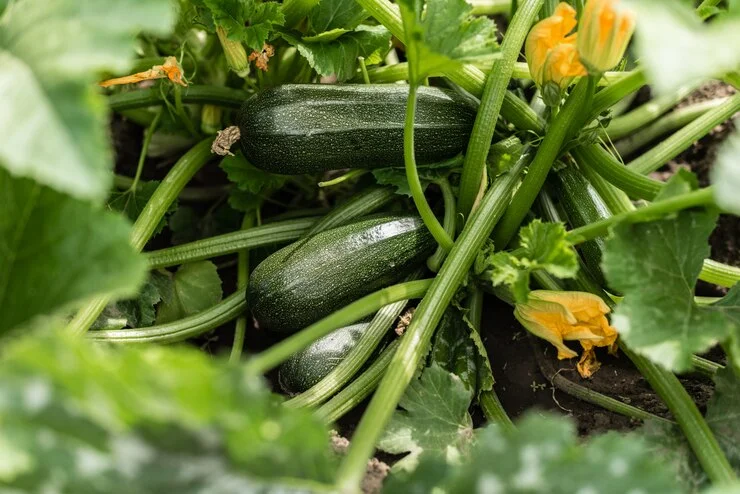
- Planting Times: Sow seeds directly in warm soil (at least 70°F) 1-2 weeks after last spring frost. Or start early indoors 3-4 weeks before planting out for transplants.
- Growth Habits: Vining squash varieties like zucchini and crookneck need ample room to ramble, 3-4 feet between hills/plants. Bush types like patio zucchinis are more compact.
- Protecting Seedlings: Young squash plants are very tender. Use row covers, cloches or cold frames to protect from pests, harsh sun, and late frosts after planting out.
- Harvest Often: For straight, tender squash, harvest fruits when 6-8″ long by cutting from the vine. The more you pick, the more new squash will grow! Don’t let fruits over-mature.
- Battling Squash Borers: These destructive insects lay eggs at the base of vines. Cover stems with soil, foil wraps or netting to prevent access. Inspect regularly.
| Zucchini Variety | Description |
|---|---|
| Black Beauty | Dark green zucchini with outstanding flavor and yields |
| Cash-flow | Plump, cylinder-shaped yellow squash with creamy texture |
| Ronde de Nice | Round, golden baseball bat-shaped squash from France |
| Sunburst | Delicious yellow patty pan squash with scalloped edges |
4. Green Beans
One of the most prolific and fast-growing crops for your garden! Green beans are extremely versatile – enjoy them fresh in salads, steamed, sauteed or even pickled.
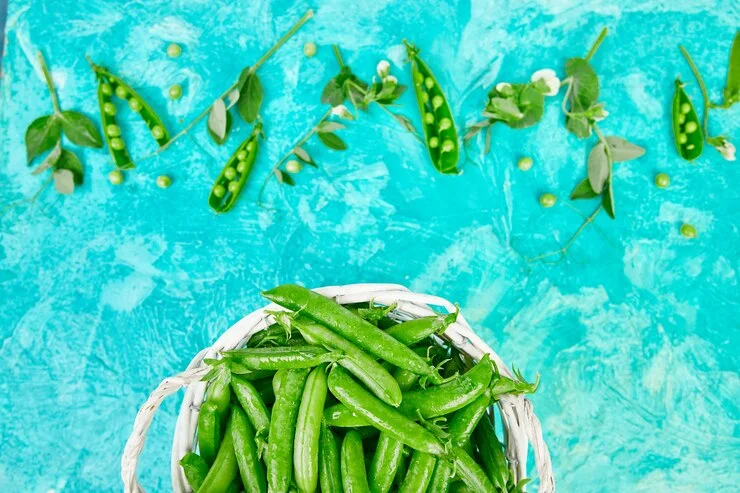
- Growing Conditions: Beans thrive in full sun (at least 6 hours per day) and nutrient-rich, well-drained soil. Add aged compost or fertilizer before planting.
- Planting Times: Sow seeds directly in the ground 1-2 weeks after your last expected frost in spring. For a continual harvest, plant a new row every 2-3 weeks until midsummer.
- Bush vs Pole Types: Bush beans are compact (2ft tall) and don’t require staking. Pole varieties will vine upwards of 5-6ft and need a trellis for support.
- Support for Pole Beans: Use bamboo tepees, wire cages, trellises or even an existing fence as a support for vining pole bean plants to climb.
- Harvesting: Check plants every 2-3 days and keep picking to encourage continuous production. Use both hands to gently pull beans off the plant to avoid damaging it.
- Varieties to Grow: For green beans – Provider, Contender, Blue Lake. For fun colors, try yellow beans like Cherokee Wax or purple types like Royal Burgundy. Grow half-runner varieties like Lazy Housewife if you want both bush and pole characteristics.
5. Carrots
The humble carrot earns its place in any veggie plot with its reliable, nutrient-rich yields and hardiness. Here’s how to grow picture-perfect carrots:
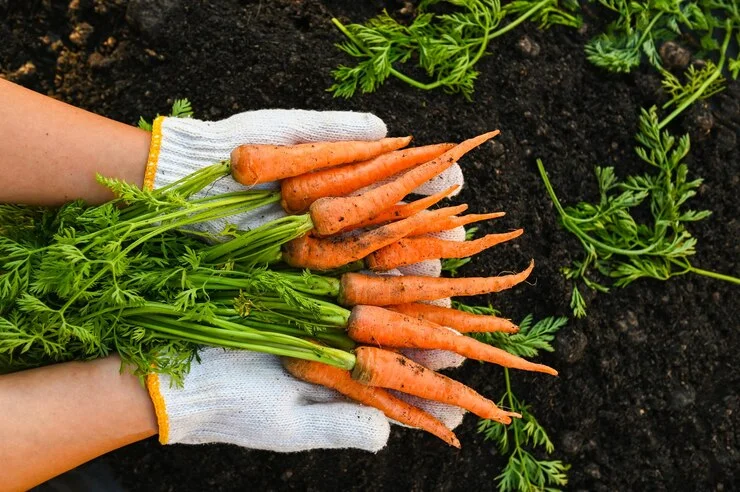
- Planting Carrots: Sow carrot seeds directly in loose, stone-free soil as soon as the ground can be worked in early spring. Seeds need soil temps around 50-60°F to germinate.
- Full Sun Required: Carrots are hardy but do best with at least 6 hours of direct sunlight per day. Too much shade can result in small, deformed roots.
- Soil Needs: Well-drained, loose soil is critical for smooth carrot growth. Amend clay or rocky soil by mixing in aged compost and sand to lighten it up.
- Thinning is Key: Once carrot seedlings have their first set of true leaves, thin them to 1-2 inches apart. This gives roots room to expand.
- Succession Planting: For a continual harvest, sow new rows every 3-4 weeks, ending by midsummer while nights are still cool.
- Storage Options: Pull up carrots anytime once they reach the desired size. Leave smaller ones to size up! For winter storage, dig up remaining carrots before hard freeze and store in damp soil or sand.
- Varieties to Try: Purple haze (purple exterior), Cosmic Purple (intense purple interior), Thumbelina (round baby carrots), Nantes (cylindrical shaped).
6. Radishes
If you’re looking for both nutrition and instant gardening gratification, radishes are your crop! These spicy little roots can go from seed to plate in as little as 3 weeks.
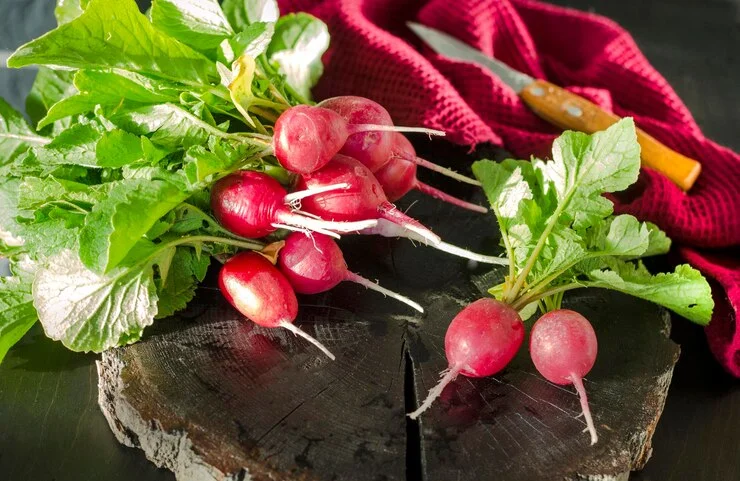
- Ideal Growing Conditions: Radishes thrive in full sun and cooler temps between 50-70°F. Hot weather makes their skins pithy and roots inedible. Loosen soil well.
- Quick from Seed: Sow radish seeds about 1⁄2″ deep and 1″ apart directly into soft, well-drained garden soil in early spring or late summer/fall. Germinates in just a few days!
- Endless Sowing Period: For a continuous supply, sow a new row of radish seeds every 1-2 weeks, finishing about a month before your first fall frost date.
- Thinning is Important: Thin radish stands to about 1″ apart once sprouted so roots can size up without crowding. Thinned radish greens make a nutritious sauté!
- Harvest Early: Don’t let radishes linger after mature. Pull them when roots are between 1⁄2″ – 1″ diameter for best texture and flavor. Oversize = woody.
- Spice Up Your Planting: Try unique radish varieties like watermelon, purple plum, black Spanish, French breakfast, or daikon for different shapes, colors, and heat levels.
- Companion Planting: Radishes can be planted closely with most other veggies without competing for nutrients. They help aerate soil as they grow.
7. Leafy Greens
Salad fans, take note! Leafy greens like lettuce, spinach, arugula and kale grow quickly and can give you an almost year-round supply of fresh, nutritious leaves.
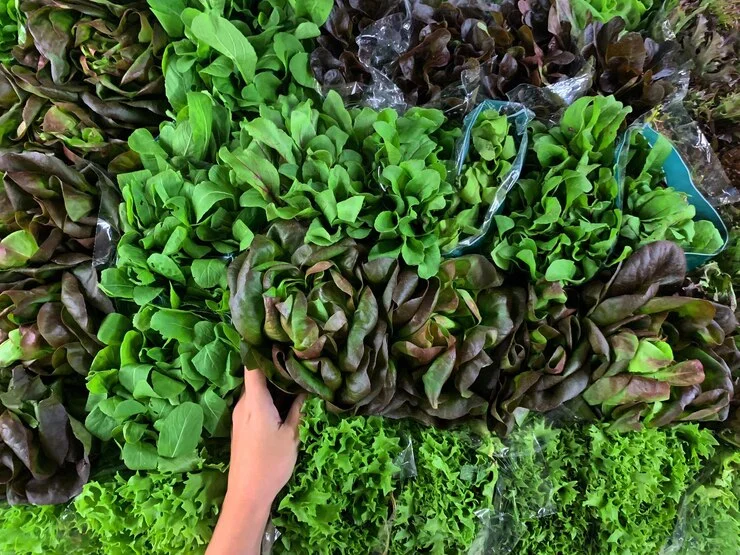
- Ideal Growing Conditions: Most greens thrive in slightly cooler temperatures (50-70°F) and appreciate part afternoon shade in hot climates. Well-drained, moisture-retentive soil is preferable.
- Spring and Fall Crops: Sow seeds directly in garden beds 4-6 weeks before the last spring frost. Then sow a second round in late summer for fall harvests.
- Succession Sowing: For a continual harvest, sow greens seeds every 1-2 weeks in small batches. As plants are picked, new ones come up behind them.
- Cut and Come Again: Instead of pulling whole plants, use scissors to shear outer leaves about an inch above the crown. This allows greens to keep producing.
- Baby vs Full Heads: Baby greens harvested at 3-4″ tall have a mild, sweet flavor. Let them grow to full heads for more robust taste and texture.
- Protection from Heat: Once temps soar over 80°F, shade greens bed with breathable row cover or use cold frames to extend the harvest window.
- Variety to Grow: Loose leaf lettuces like Black Seeded Simpson mature quickly. Romaines like Parris Island form tight heads. Try nutrient-rich spinaches like Bloomsdale Longstanding or rubbed-tinged Red Russian kale.
8. Cucumbers
When it comes to prolific vegetable vines, cucumbers reign supreme! These tasty backyard treats are perfect for slicing into salads, pickling or even eating straight off the vine!
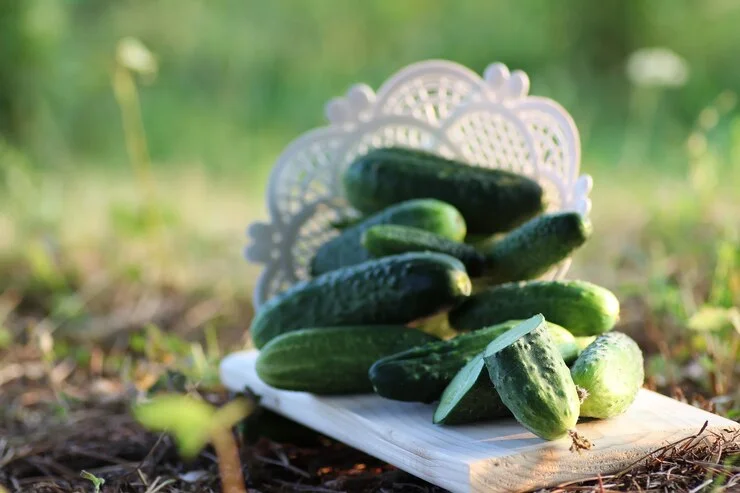
- Ideal Growing Conditions: Cucumbers require warmer temps (65-90°F), full sun exposure, and well-draining, nutrient-rich soil amended with compost or fertilizer. Consistent moisture is key.
- Planting Times: Sow seeds directly into warm garden soil (at least 60°F) 1-2 weeks after your last expected spring frost. Or start transplants 4 weeks earlier.
- Support for Vining: Cucumber plants can vine 6+ feet long, so they’ll need support like a trellis, cage or stakes. This prevents soil-borne diseases and increases yields.
- Bush vs Vining Types: For limited space gardens, consider compact bush varieties that don’t require trellising. For bigger yields, choose vigorous vining types.
- Consistent Watering: Uneven watering can lead cucumbers to become stunted, bitter or misshapen. Aim for 1-2″ of water per week through drip irrigation or soaked hoses.
- Harvest Early and Often: Don’t wait for cucumbers to turn yellow and over-mature. Harvest every 2-3 days when the size is right for your desired variety (6-8″ is typical).
- Varities to Try: Lemon cucumber, Straight Eight, Diva, Boston Pickling, Muncher (burpless), Marketmore 76 (slicing), Space Master (compact bush type).
9. Potatoes
Spuds may seem like an unlikely crop for smaller gardens, but potatoes are surprisingly easy to grow – and prolific! Follow these tips for a hearty homegrown harvest.
- Exposure and Spacing: Potatoes thrive in full to partial sun exposures with well-draining, loose soil. Space seed pieces or plants 12″ apart in rows 3′ apart.
- Planting Times: Plant certified seed potatoes 2-3 weeks before your last spring frost date once soil has mostly thawed and dried out.
- Hilling Up: As potato plants emerge, cover stems with soil or straw leaving just a few inches exposed. This forces tubers to grow larger beneath the hills.
- Watering and Feeding: Potato plants need 1-2″ of water per week, especially as tubers form. Side-dress plants with compost or fertilizer for robust growth.
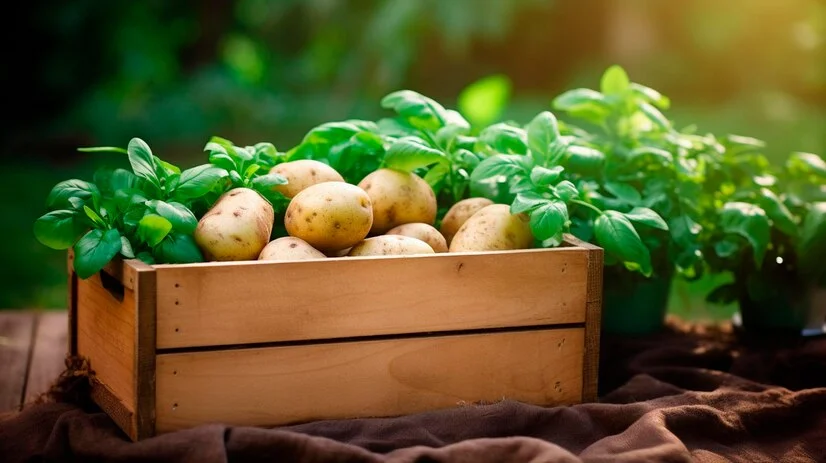
- Pest Protection: Rotate potato crop locations annually to prevent soil pests and diseases. Use row covers until plants flower to block pests like Colorado potato beetles.
- Harvest Time: New potatoes can be harvested once plants flower by carefully reaching into the hills and finding some spuds. For full harvests, wait 2-3 weeks after plants die back.
- Curing Potatoes: After digging up mature potatoes, let them sit in a shaded area for 10-14 days to allow skins to cure before storing long-term.
- Variety Options: Go for versatile, disease-resistant modern varieties like Yukon Gold, Red Pontiac, and Kennebec. Or try gourmet types like Russian Banana fingerlings and Purple Majesty.
10. Onions
Onions are an indispensable culinary staple, layering flavor onto countless dishes. They’re also a prime candidate for the home garden plot.
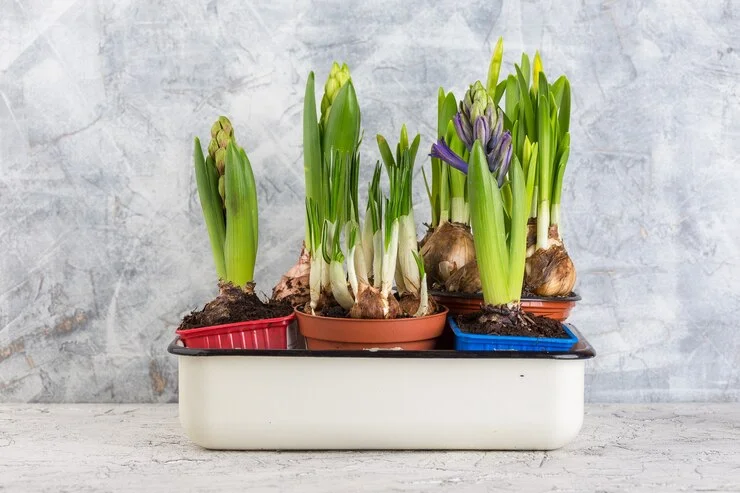
- Planting Times: Plant onion sets, seeds or transplants as soon as the ground can be worked in early spring. Onions require a long growing season.
- Soil Prep: Onions perform best in loose, well-draining soil about 6-7″ deep, free of stones. Raised beds are ideal. Amend with compost before planting.
- Short vs Long-Day: Match onion varieties to your day-length. Long-day onions (Spanish/yellow types) need 14+ hours, short-day (red/white types) only 10-12 hours.
- Perfect Spacing: Plant onion sets 1″ deep and 4-6″ apart in rows 12-16″ apart. Onions from seed or transplants can be closer at 2-3″ spacing.
- Steady Water Needs: Onions have shallow root systems and require consistent moisture to produce large bulbs. Water at the soil level when the top inch gets dry.
- Curing for Storage: Once tops flop over, stop watering. After 1-2 weeks, pull mature bulbs and cure in a warm, dry area for 2 weeks before storing.
- Variety Highlights: For storage keepers, try Yellow Sweet Spanish, Redwing, or Stuttgarter. Milder favorites include Walla Walla sweets and green onions like Evergreen Bunching.
11. Herbs
No home vegetable garden is truly complete without a fresh herb garden component! Herbs add incredible aroma, zest and nutrition to homemade meals.
- Container Friendly: Many herbs can be grown in containers or window boxes if limited on space. Just ensure proper drainage and at least 6 hours of direct sun.
- Successive Planting: As herbs like cilantro and dill tend to bolt in summer’s heat, sow seeds every few weeks for a continual fresh supply.
- Frequent Harvesting: The more often you harvest, the better herbs will continue producing. Don’t let plants go to flower or they may stop growing leaves.
- Drying and Storage: To enjoy herbs through winter, bundle stems together and hang upside down in dry area until completely crisp. Store in airtight containers.
- Frost Protection: Herbs like rosemary, sage and thyme are cold-hardy but may benefit from a sheltered location or light mulching over winter.
- Varieties to Grow: Must-haves include basil, parsley, cilantro, thyme, rosemary, dill, chives, mint, oregano and lavender. Explore less common ones like lemon balm too!
Gardening Tips & Techniques
In addition to the pointers listed above for each crop, here are some general gardening tips and techniques to get the most out of your 2024 vegetable plot:
Raised Beds vs In-Ground Gardens: Raised beds offer excellent drainage and yield increase by concentrating soil volume. In-ground beds integrate more into a landscape.
Vertical Gardening Methods: To maximize space, trellis vining crops like cucumbers, pole beans, peas and tall indeterminate tomatoes upwards.
Mulching: A 2-3″ layer of mulch like straw, leaves or grass clippings conserves moisture and suppresses weeds. Replenish as needed.
Organic Pest Control: Encourage beneficial insects with wildflowers. Try homemade deterrents like neem oil, diatomaceous earth and row covers.
Extending Harvests: Use cold frames, row covers or relocate plants under high tunnels to keep harvests going through late fall.
Food Preservation: To enjoy your bounty all year, learn proper canning, freezing, pickling and drying techniques for longer storage.
Crop Rotation: Switching up where vegetables are planted each year helps prevent pest and disease buildup while replenishing soil nutrients.
Companion Planting: Grow plants together that have complementary needs and can assist each other, like the “three sisters” – corn, beans, and squash.
Gardening Records: Take notes! Track planting times, successes/failures, weather conditions and harvests to hone your green thumb next season.
People Also Ask
When is the best time to start a vegetable garden?
The optimal time to start your vegetable garden varies based on your climate, but generally you’ll want to start cool-season crops like lettuce, spinach, and peas 4-6 weeks before your last expected spring frost date. For warm weather veggies like tomatoes and peppers, you’ll need to wait until 2-3 weeks after the last frost to plant.
How much sun do vegetable plants need?
Most vegetables need at least 6-8 hours of direct sunlight per day to thrive. Root crops like carrots, beets, and potatoes can get by with slightly less at 5-6 hours of sun. Leafy greens may appreciate some afternoon shade in hot climates.
What vegetables are easy for beginner gardeners?
Excellent starter vegetables for new gardeners include zucchini, green beans, radishes, lettuce, tomatoes, cucumbers and herbs like basil and cilantro. These crops are relatively low-maintenance, productive and quick from seed to harvest.
How do you keep pests away from vegetable plants naturally?
There are many organic methods like applying neem oil or hot pepper wax sprays, introducing beneficial insects, using row covers, incorporating companion plants that deter pests, and practicing yearly crop rotation. Handpicking bugs is another highly effective technique. Avoid harsh chemical pesticides that harm beneficial organisms.
What vegetables can you grow in partial shade?
While most veggie crops need at least 6 hours of direct sun, leafy greens like lettuce, spinach, kale and root vegetables like beets, carrots and radishes can tolerate partial shade getting about 4 hours of direct sunlight per day. Plant these in areas that receive morning sun and afternoon shade.
Conclusion
There you have it – your comprehensive road map to a vegetable garden overflowing with fresh, homegrown produce throughout 2024! By following these planning tips and growing methods for 11 rewarding star crops, you’ll be rewarded with an abundant harvest.
So get those seed catalogs out, prepare your garden beds, and start dreaming of your first ripe tomatoes, crisp salads, and bountiful veggie hauls this coming season. With the proper care, patience and knowledge, you’re well on your way to productive vegetable gardening and months of healthy, delicious homemade meals. Happy planting, gardeners!
